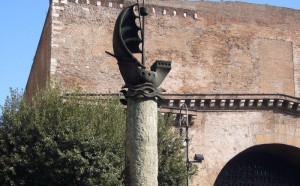FEATURES From Paris to Rome, A Vessel That Overcomes the Storm
“Fluctuat nec mergitur”, Tossed but not sunk: it is the motto of Paris, referring to its symbol, a ship sailing through a stormy sea. But the same symbol represents Paris in the sky of the twinned city Rome, where a bronze statue stands bringing a little bit of the City of Light in the Eternal City, because “Only Paris is worthy of Rome, only Rome is worthy of Paris”.
The vessel was erected on the top of a column close to Paris Street, in front of the National Order of Journalists, the Castro Pretorio, the Grand Hotel and the red church of Maria degli Angeli. The motto of France’s capital has now become also the slogan of the world’s battle against terrorism. Waking up after the most terrible of nights, Parisians found it written in a huge new graffiti at the Place de la République, drawn by a group of writers. And all the web’s surfers saw it on the Instagram profile of Joann Sfar, author of the famous comic Le Chat du Rabbin, who published a series of twelve raging yet tender drawings. Those ancient Latin words for him mean that it is necessary not to be intimidated by deathly violence and to go on, for this is what Paris has always done.
The history of Paris is the history of a city that never sinks, but resists the most abnormal waves, showing its force with pride since 1190, when king Philip II chose the ship – called Scilicet, Latin for “of course” – as its first blason. The vessel has always been the symbol of the water sellers and merchants whose powerful corporation was at the origin of the creation of the municipality of Paris. It was born during the Middle Ages and from the very beginning it became representative of a urban oligarchy. During the Ancien Régime the provost of the merchants, with four counselors, was in charge of supplies for the city, public works, taxes and had jurisdiction over the river trade. The charge had thus become, in practice, that of a mayor.
In its complete representation in the coat of arms are also represented the decorations of the city, the Legion of Honour, the Croix de guerre 1914-1918 and the Croix de la Libération. The vessel is topped by a crown of lilies and golden walls with five towers, and surrounded by an oak branch to the right and by a laurel branch to the left, while the motto is usually written below.
Today the ship and the words “fluctuat nec mergitur” stand out on the Hôtel de Ville, the city hall of Paris, those of other districts, in stations, bridges and schools, in some stamps, but also in the lyrics of the song “Les Copains D ‘Abord” by Georges Brassens and the logo of the Olympic Games in 1924. And now also in the heart of Parisians and of all those who wish to say a firm no to terror, shouting those words as proud cries in a battle for life. Because, as Sfar wrote in one of his drawings, “those who love, those who love life, in the end they always win.”

